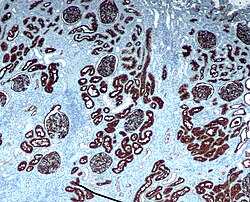Immunohistochemistry
Immunohistochemistry (IHC) it involves the process of selectively identifying antigens in cells of a tissue section by exploiting the principle of antibodies binding specifically to antigens in biological tissues.[1][2] IHC takes its name from the roots "immuno", which simply means antibodies used in the procedure, and "histo", means. Immunohistochemistry was been conceptualized by Albert Coons.[3][4]
Sample Preparation
This involve proper tissue collection, fixation and sectioning. A solution of formalin is often used to fix tissue, but other methods may also be used.
Immunohistochemistry Media
Immunofluorescence of human skin using an anti-IgA antibody. The skin is from a patient with Henoch–Schönlein purpura: IgA deposits are found in the walls of small superficial capillaries (yellow arrows). The pale wavy green area on top is the epidermis, the bottom fibrous area is the dermis.
Chromogenic immunohistochemistry: The cell is exposed to a primary antibody (red) that binds to a specific antigen (purple square). The primary antibody binds a secondary (green) antibody that is chemically coupled to an enzyme (blue). The enzyme changes the color of the substrate to a more pigmented one (brown star).
Immunohistochemistry stain versus hematoxylin counterstain.
References
- ↑ Ramos-Vara, J. A.; Miller, M. A. (2014). "When Tissue Antigens and Antibodies Get Along". Veterinary Pathology. 51 (1): 42–87. doi:10.1177/0300985813505879. PMID 24129895. S2CID 24776407.
- ↑ "Overview of Immunohistochemistry - US". www.thermofisher.com. Retrieved 2021-11-21.
- ↑ "immunohistochemistry". www.cancer.gov. 2011-02-02. Retrieved 2021-11-21.
- ↑ "Immunohistochemistry Principle & Protocol". Bosterbio. Archived from the original on 2021-11-21. Retrieved 2021-11-21.







